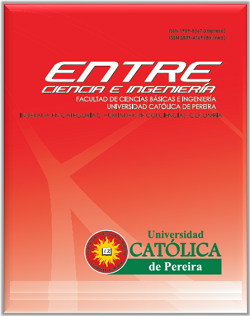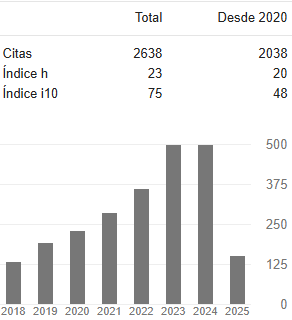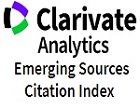Contaminación del agua por metales pesados, métodos de análisis y tecnologías de remoción. Una revisión
DOI:
https://doi.org/10.31908/19098367.1734Palabras clave:
contaminación, fuentes hídricas, mercurio, métodos de análisis, técnicas de remociónResumen
Los sistemas de producción industrial actuales usan metales pesados para la extracción de un material o como elemento en la refinación de un producto en particular lo que en principio resulta en la obtención del producto deseado con relativos bajos costos de producción. Sin embargo, usar estos metales presenta un grave problema a nivel ambiental debido a sus altos niveles de toxicidad para los organismos con los que interactúen una vez son descargados. Por tanto, se han desarrollado diversos métodos para tratar con estos metales una vez están en el agua y los métodos para analizarlos. Se realizó una búsqueda amplia y actualizada de las fuentes, efectos y toxicidad en los seres vivos, métodos de análisis y las diversas técnicas de tratamiento existentes para metales pesados. Como resultado el investigador estará más preparado al tener información actual sobre los tratamientos a tener en cuenta en la manipulación de metales pesados.
Descargas
Referencias
L. F. Londoño Franco, P. T. Londoño Muñoz, and F. G. Muñoz Garcia, “Los riesgos de los metales pesados en la salud humana y animal,” Biotecnoloía en el Sect. Agropecu. y Agroindustrial, vol. 14, no. 2, p. 145, 2016.
J. Contreras Pérez, C. L. Mendoza, and A. Gómez, “Determinación de metales pesados en aguas y sedimentos del río Haina,” Cienc. Soc., vol. 29, no. 1, pp. 38–71, 2004.
O. Cartaya, I. Reynaldo, and C. Peniche, “Cinética De Adsorción De Iones Cobre (II) Por Una Mezcla De Oligogalacturónidos,” Rev. Iberoam. Polímero Vol. Iberoam. Polim, vol. 9, no. 95, pp. 473–479, 2008.
R. Vilchez, “Eliminación de metales pesados de aguas subterráneas mediante sistemas de lechos sumergidos: Estudio microbiológico de las biopeliculas,” Universidad de Granada, 2005.
Y. C. Reyes, I. Vergara, O. E. Torres, M. Díaz, and E. E. González, “Contaminación Por Metales Pesados: Implicaciones En Salud, Ambiente Y Seguridad Alimentaria,” Ing. Investig. y Desarro., vol. 16, no. 2, pp. 66–77, 2016.
C. Azpilicueta, L. Pena, and S. Gallego, “Los metales y las plantas: entre la nutrición y la toxicidad,” Cienc. Hoy, vol. 20, p. 5, 2010.
S. Suthersan, “Evaluación de las tecnologías de tratamiento de aguas subterráneas contaminadas con Cromo,” p. 105, 2007.
C. Nava-Ruíz and M. Méndez-Armenta, “Efectos neurotóxicos de metales pesados (cadmio, plomo, arsénico y talio),” Arch. Neurociencias, vol. 16, no. 3, pp. 140–147, 2011.
C. Tejada-Tovar, Á. Villabona-Ortiz, and L. Garcés-Jaraba, “Adsorción de metales pesados en aguas residuales usando materiales de origen biológico,” Tecno Lógicas, vol. 18, no. 34, pp. 109–123, 2015.
S. E. Manahan, Introducción a la química ambiental. Editorial Reverté, 2007.
V. E. Gomez Rengifo, J. A. Velásquez Jiménez, and G. C. Quintana Marín, “Lignina como adsorbente de metales pesados,” Rev. Investig. Apl., vol. 7, no. 2, pp. 74–85, 2013.
P. Trivedi and L. Axe, “Modeling Cd and Zn sorption to hydrous metal oxides,” Environ. Sci. Technol., vol. 34, no. 11, pp. 2215–2223, 2000.
M. A. Ahmed, S. M. Ali, S. I. El-Dek, and A. Galal, “Magnetite-hematite nanoparticles prepared by green methods for heavy metal ions removal from water,” Mater. Sci. Eng. B Solid-State Mater. Adv. Technol., vol. 178, no. 10, pp. 744–751, 2013.
D. Mohan, K. P. Singh, and V. K. Singh, “Trivalent chromium removal from wastewater using low cost activated carbon derived from agricultural waste material and activated carbon fabric cloth,” J. Hazard. Mater., vol. 135, no. 1–3, pp. 280–295, 2006.
O. C. S. Al Hamouz, M. Estatie, and T. A. Saleh, “Removal of cadmium ions from wastewater by dithiocarbamate functionalized pyrrole based terpolymers,” Sep. Purif. Technol., vol. 177, pp. 101–109, 2017.
C. Y. Wu, H. Mouri, S. S. Chen, D. Z. Zhang, M. Koga, and J. Kobayashi, “Removal of trace-amount mercury from wastewater by forward osmosis,” J. Water Process Eng., vol. 14, pp. 108–116, 2016.
A. M. Mohammad, T. A. Salah Eldin, M. A. Hassan, and B. E. El-Anadouli, “Efficient treatment of lead-containing wastewater by hydroxyapatite/chitosan nanostructures,” Arab. J. Chem., vol. 10, no. 5, pp. 683–690, 2017.
Ministerio de la Presidencia, “Real Decreto 140/2003, de 7 de febrero, por el que se establecen los criterios sanitarios de la calidad del agua de consumo humano.,” Bol. Of. del estado, pp. 7228–7245, 2003.
Instituto colombiano de normas técnicas y certificación, “Norma Técnica Colombiana Ntc 813,” vol. 813, pp. 1–10, 2011.
O. US EPA, “National Primary Drinking Water Regulations.” [Online]. Available: https://www.epa.gov/ground-water-and-drinking-water/national-primary-drinking-water-regulations#one. [Accessed: 09-Apr-2019].
C. García, J. L. Moreno, M. Teresa, and A. Polo, “Metales pesados y sus implicaciones en la calidad del suelo,” Cienc. y Medio Ambient., p. 14, 2002.
B. Wang, Y. Zhu, Z. Bai, R. Luque, and J. Xuan, “Functionalized chitosan biosorbents with ultra-high performance, mechanical strength and tunable selectivity for heavy metals in wastewater treatment,” Chem. Eng. J., vol. 325, pp. 350–359, 2017.
C. F. Carolin, P. S. Kumar, A. Saravanan, G. J. Joshiba, and M. Naushad, “Efficient techniques for the removal of toxic heavy metals from aquatic environment: A review,” J. Environ. Chem. Eng., vol. 5, no. 3, pp. 2782–2799, 2017.
C. M. Mejia Dominguez, “Metales Pesados En Suelos Y Plantas: Contaminación Y Fitotoxicidad,” 2011.
O. L. B. Moreno, “Estudio de diferentes metodologías para determinar la biodisponibilidad de cadmio y arsénico en suelos y su relación con la concentración en plantas,” Nova, vol. 6, no. 9, pp. 35–39, 2008.
L. E. Cortés, F. J. Martin, and M. M. Sarria, “Evaluación de la toxicidad de metales pesados en dos suelos agrícolas de Colombia mediante bioensayos Evaluation of heavy metal toxicity in two Colombian agricultural soils using,” 2017.
“What is a LD50 and LC50? : OSH Answers.” [Online]. Available: http://www.ccohs.ca/oshanswers/chemicals/ld50.html. [Accessed: 20-May-2018].
C. Baird, Química ambiental. University of Western. Ontario: Editorial Reverté, 2001.
X. Domènech and J. Peral, Química ambiental de sistemas terrestres. Barcelona, España: Reverté, 2006.
D. W. O’Connell, C. Birkinshaw, and T. F. O’Dwyer, “Heavy metal adsorbents prepared from the modification of cellulose: A review,” Bioresour. Technol., vol. 99, no. 15, pp. 6709–6724, 2008.
K. Leopold, A. Philippe, K. Wörle, and G. E. Schaumann, “Analytical strategies to the determination of metal-containing nanoparticles in environmental waters,” TrAC Trends Anal. Chem., vol. 84, pp. 107–120, Nov. 2016.
P. Pohl, P. Jamroz, M. Welna, A. Szymczycha-Madeja, and K. Greda, “Chemical-vapor generation of transition metals through the reaction with tetrahydroborate in recent achievements in analytical atomic spectrometry,” TrAC Trends Anal. Chem., vol. 59, pp. 144–155, Jul. 2014.
A. T. Reis, C. M. Davidson, C. Vale, and E. Pereira, “Overview and challenges of mercury fractionation and speciation in soils,” TrAC Trends Anal. Chem., vol. 82, pp. 109–117, Sep. 2016.
S. L. C. Ferreira et al., “Atomic absorption spectrometry – A multi element technique,” TrAC Trends Anal. Chem., vol. 100, pp. 1–6, Mar. 2018.
M. Shen, L. Chen, W. Han, and A. Ma, “Methods for the determination of heavy metals in indocalamus leaves after different preservation treatment using inductively-coupled plasma mass spectrometry,” Microchem. J., vol. 139, pp. 295–300, Jun. 2018.
A. Harris, S. J. Xanthos, J. K. Galiotos, and C. Douvris, “Investigation of the metal content of sediments around the historically polluted Potomac River basin in Washington D.C., United States by inductively coupled plasma-optical emission spectroscopy (ICP-OES),” Microchem. J., vol. 142, pp. 140–143, Nov. 2018.
M. I. S. Rojas, “La espectrometría de emisión con fuente de plasma de acoplamiento inductivo Inductively coupled plasma emission spectrometry,” Mater. Construcción, vol. 36, no. 202, pp. 31–46, 1986.
B. Romberg and H. Müller, “Photometric screening-test for heavy metals under flow injection conditions using extractive determination with dithizone,” Anal. Chim. Acta, vol. 353, no. 2–3, pp. 165–172, Oct. 1997.
S.-H. Chen et al., “Electrochemical spectral methods for trace detection of heavy metals: A review,” TrAC Trends Anal. Chem., vol. 106, pp. 139–150, Sep. 2018.
E. Bulska, “Analytical advantages of using electrochemistry for atomic spectrometry,” Pure Appl. Chem., vol. 73, no. 1, pp. 1–7, Jan. 2001.
S. Wang, E. S. Forzani, and N. Tao, “Detection of Heavy Metal Ions in Water by High-Resolution Surface Plasmon Resonance Spectroscopy Combined with Anodic Stripping Voltammetry,” Anal. Chem., vol. 79, no. 12, pp. 4427–4432, Jun. 2007.
E. Marguí, R. Van Grieken, C. Fontàs, M. Hidalgo, and I. Queralt, “Preconcentration Methods for the Analysis of Liquid Samples by X-Ray Fluorescence Techniques,” Appl. Spectrosc. Rev., vol. 45, no. 3, pp. 179–205, May 2010.
D. I. C. Rubio, R. A. M. Calderón, A. P. Gualtero, D. R. Acosta, and I. J. S. Rojas, “Tratamientos para la Remoción de Metales Pesados Comúnmente Presentes en Aguas Residuales Industriales. Una Revisión,” Rev. Ing. y Región, vol. 13, no. 1, pp. 73–90, 2015.
J. Taylor and M. Wiesner, Calidad y tratamiento del agua : manual de suministros de agua comunitaria. Madrid, España: McGraw-Hill, 2002.
N. L. Nemerow and A. Dasgupta, Tratamiento de vertidos industriales y peligrosos. Ediciones Díaz de Santos, 2000.
Y. Ji, “Membrane technologies for water treatment and reuse in the gas and petrochemical industries,” in Advances in Membrane Technologies for Water Treatment, Elsevier, 2015, pp. 519–536.
“Nanofiltration Device Pictures to Pin on Pinterest - PinsDaddy.” [Online]. Available: http://www.pinsdaddy.com/nanofiltration-device_JzLzpW2NQPbU5Wb4*hNS1hbCHndH1lhn50tVQFop6gc/. [Accessed: 10-Apr-2019].
E. Brillas and P.-L. Cabot, Trends in electrochemistry and corrosion at the beginning of the 21st century : dedicated to professor Dr. Josep M. Costa on the occasion of his 70th birthday. Publicacions Universitat de Barcelona, 2004.
Y. Liu, J. Yan, D. Yuan, Q. Li, and X. Wu, “The study of lead removal from aqueous solution using an electrochemical method with a stainless steel net electrode coated with single wall carbon nanotubes,” Chem. Eng. J., vol. 218, pp. 81–88, Feb. 2013.
C.-V. Gherasim, J. Křivčík, and P. Mikulášek, “Investigation of batch electrodialysis process for removal of lead ions from aqueous solutions,” Chem. Eng. J., vol. 256, pp. 324–334, Nov. 2014.
T. Scarazzato, Z. Panossian, J. A. S. Tenório, V. Pérez-Herranz, and D. C. R. Espinosa, “A review of cleaner production in electroplating industries using electrodialysis,” J. Clean. Prod., vol. 168, pp. 1590–1602, 2017.
M. Bilal et al., “Waste biomass adsorbents for copper removal from industrial wastewater—A review,” J. Hazard. Mater., vol. 263, pp. 322–333, Dec. 2013.
M. P. González et al., “Effect of phosphoric and hydrofluoric acid on the charge density of a nanofiltration membrane,” Desalination, vol. 200, no. 1–3, pp. 361–363, Nov. 2006.
F. Fu and Q. Wang, “Removal of heavy metal ions from wastewaters: A review,” J. Environ. Manage., vol. 92, no. 3, pp. 407–418, Mar. 2011.
W. Tao et al., “Influence of silver nanoparticles on heavy metals of pore water in contaminated river sediments,” Chemosphere, vol. 162, pp. 117–124, Nov. 2016.
S. S. Hosseini, E. Bringas, N. R. Tan, I. Ortiz, M. Ghahramani, and M. A. Alaei Shahmirzadi, “Recent progress in development of high performance polymeric membranes and materials for metal plating wastewater treatment: A review,” J. Water Process Eng., vol. 9, pp. 78–110, Feb. 2016.
A. A. Mungray, S. V. Kulkarni, and A. K. Mungray, “Removal of heavy metals from wastewater using micellar enhanced ultrafiltration technique: a review,” Cent. Eur. J. Chem., vol. 10, no. 1, pp. 27–46, Feb. 2012.
J. Landaburu-Aguirre, V. García, E. Pongrácz, and R. L. Keiski, “The removal of zinc from synthetic wastewaters by micellar-enhanced ultrafiltration: statistical design of experiments,” Desalination, vol. 240, no. 1–3, pp. 262–269, May 2009.
T. M. Zewail and N. S. Yousef, “Kinetic study of heavy metal ions removal by ion exchange in batch conical air spouted bed,” Alexandria Eng. J., vol. 54, no. 1, pp. 83–90, Mar. 2015.
Z. Hubicki and D. Koodynsk, “Selective Removal of Heavy Metal Ions from Waters and Waste Waters Using Ion Exchange Methods,” in Ion Exchange Technologies, InTech, 2012.
“Water quality information - Water Purification Technologies - Ion exchange | APEC Water.” [Online]. Available: https://www.freedrinkingwater.com/water-education/quality-water-filtration-method-ion-exchange.htm. [Accessed: 12-Apr-2019].
Y. Chang, J.-Y. Lai, and D.-J. Lee, “Thermodynamic parameters for adsorption equilibrium of heavy metals and dyes from wastewaters: Research updated,” Bioresour. Technol., vol. 222, pp. 513–516, Dec. 2016.
A. T. Ojedokun and O. S. Bello, “Sequestering heavy metals from wastewater using cow dung,” Water Resour. Ind., vol. 13, pp. 7–13, Mar. 2016.
A. Demirbas, “Heavy metal adsorption onto agro-based waste materials: A review,” J. Hazard. Mater., vol. 157, no. 2–3, pp. 220–229, Sep. 2008.
B. E. Saad, “Chapter 3 PRINCIPLES OF ADSORPTION,” pp. 41–65, 2016.
A. Ewecharoen, P. Thiravetyan, E. Wendel, and H. Bertagnolli, “Nickel adsorption by sodium polyacrylate-grafted activated carbon,” J. Hazard. Mater., vol. 171, no. 1–3, pp. 335–339, Nov. 2009.
W. S. Wan Ngah, L. C. Teong, and M. A. K. M. Hanafiah, “Adsorption of dyes and heavy metal ions by chitosan composites: A review,” Carbohydr. Polym., vol. 83, no. 4, pp. 1446–1456, Feb. 2011.
P. O. Boamah et al., “Sorption of heavy metal ions onto carboxylate chitosan derivatives—A mini-review,” Ecotoxicol. Environ. Saf., vol. 116, pp. 113–120, Jun. 2015.
G. Mezohegyi, F. P. van der Zee, J. Font, A. Fortuny, and A. Fabregat, “Towards advanced aqueous dye removal processes: A short review on the versatile role of activated carbon,” J. Environ. Manage., vol. 102, pp. 148–164, Jul. 2012.
M. Karnib, A. Kabbani, H. Holail, and Z. Olama, “Heavy Metals Removal Using Activated Carbon, Silica and Silica Activated Carbon Composite,” Energy Procedia, vol. 50, pp. 113–120, 2014.
H. Tounsadi et al., “Highly efficient activated carbon from Glebionis coronaria L. biomass: Optimization of preparation conditions and heavy metals removal using experimental design approach,” J. Environ. Chem. Eng., vol. 4, no. 4, pp. 4549–4564, Dec. 2016.
X. Ren, C. Chen, M. Nagatsu, and X. Wang, “Carbon nanotubes as adsorbents in environmental pollution management: A review,” Chemical Engineering Journal, vol. 170, no. 2–3. pp. 395–410, Jun-2011.
Ihsanullah et al., “Effect of acid modification on adsorption of hexavalent chromium (Cr(VI)) from aqueous solution by activated carbon and carbon nanotubes,” Desalin. Water Treat., vol. 57, no. 16, pp. 7232–7244, Apr. 2016.
G. Ersan, O. G. Apul, F. Perreault, and T. Karanfil, “Adsorption of organic contaminants by graphene nanosheets: A review,” Water Res., vol. 126, pp. 385–398, Dec. 2017.
J. L. Huisman, G. Schouten, and C. Schultz, “Biologically produced sulphide for purification of process streams, effluent treatment and recovery of metals in the metal and mining industry,” Hydrometallurgy, vol. 83, no. 1–4, pp. 106–113, Sep. 2006.
Q. Chen, Z. Luo, C. Hills, G. Xue, and M. Tyrer, “Precipitation of heavy metals from wastewater using simulated flue gas: Sequent additions of fly ash, lime and carbon dioxide,” Water Res., vol. 43, no. 10, pp. 2605–2614, Jun. 2009.
M. A. Hashim, S. Mukhopadhyay, J. N. Sahu, and B. Sengupta, “Remediation technologies for heavy metal contaminated groundwater,” J. Environ. Manage., vol. 92, no. 10, pp. 2355–2388, Oct. 2011.
J. Z. Zhou et al., “Effective Self-Purification of Polynary Metal Electroplating Wastewaters through Formation of Layered Double Hydroxides,” Environ. Sci. Technol., vol. 44, no. 23, pp. 8884–8890, Dec. 2010.
S. V. Jadhav, C. R. Gadipelly, K. V. Marathe, and V. K. Rathod, “Treatment of fluoride concentrates from membrane unit using salt solutions,” J. Water Process Eng., vol. 2, pp. 31–36, Jun. 2014.
A. E. Lewis, “Review of metal sulphide precipitation,” Hydrometallurgy, vol. 104, no. 2, pp. 222–234, Sep. 2010.
G. Morante, “Electrocoagulación de aguas residuales,” Rev. Colomb. Física, vol. 34, no. 2, pp. 484–487, 2002. [82] M. Visa, “Synthesis and characterization of new zeolite materials obtained from fly ash for heavy metals removal in advanced wastewater treatment,” Powder Technol., vol. 294, pp. 338–347, Jun. 2016.
D. Ghernaout et al., “Brownian Motion and Coagulation Process,” Am. J. Environ. Prot. Spec. Issue Clean. Sustain. Prod., vol. 4, no. 1, pp. 1–15, 2015.
I. M. Ismail, A. S. Fawzy, N. M. Abdel-Monem, M. H. Mahmoud, and M. A. El-Halwany, “Combined coagulation flocculation pre treatment unit for municipal wastewater,” J. Adv. Res., vol. 3, no. 4, pp. 331–336, Oct. 2012.
F. Renault, B. Sancey, P.-M. Badot, and G. Crini, “Chitosan for coagulation/flocculation processes – An eco-friendly approach,” Eur. Polym. J., vol. 45, no. 5, pp. 1337–1348, May 2009.
M. S. Melchiors, M. Piovesan, V. R. Becegato, V. A. Becegato, E. B. Tambourgi, and A. T. Paulino, “Treatment of wastewater from the dairy industry using electroflocculation and solid whey recovery,” J. Environ. Manage., vol. 182, pp. 574–580, Nov. 2016.
H. Polat and D. Erdogan, “Heavy metal removal from waste waters by ion flotation,” J. Hazard. Mater., vol. 148, no. 1–2, pp. 267–273, Sep. 2007.
F. S. Hoseinian, M. Irannajad, and A. J. Nooshabadi, “Ion flotation for removal of Ni(II) and Zn(II) ions from wastewaters,” Int. J. Miner. Process., vol. 143, pp. 131–137, Oct. 2015.
M. H. Salmani, M. Davoodi, M. H. Ehrampoush, M. T. Ghaneian, and M. H. Fallahzadah, “Removal of cadmium (II) from simulated wastewater by ion flotation technique,” Iranian J. Environ. Health Sci. Eng., vol. 10, no. 1, p. 16, 2013.
C. Páez and G. Taborda, “La fotocatálisis: aspectos fundamentales para una buena remoción de contaminantes,” Rev. la Univ. Caldas, vol. 26, no. 1–2, pp. 71–88, 2006.
Descargas
Publicado
Número
Sección
Licencia
Derechos de autor 2020 Entre Ciencia e Ingeniería

Esta obra está bajo una licencia internacional Creative Commons Atribución-NoComercial 4.0.



















